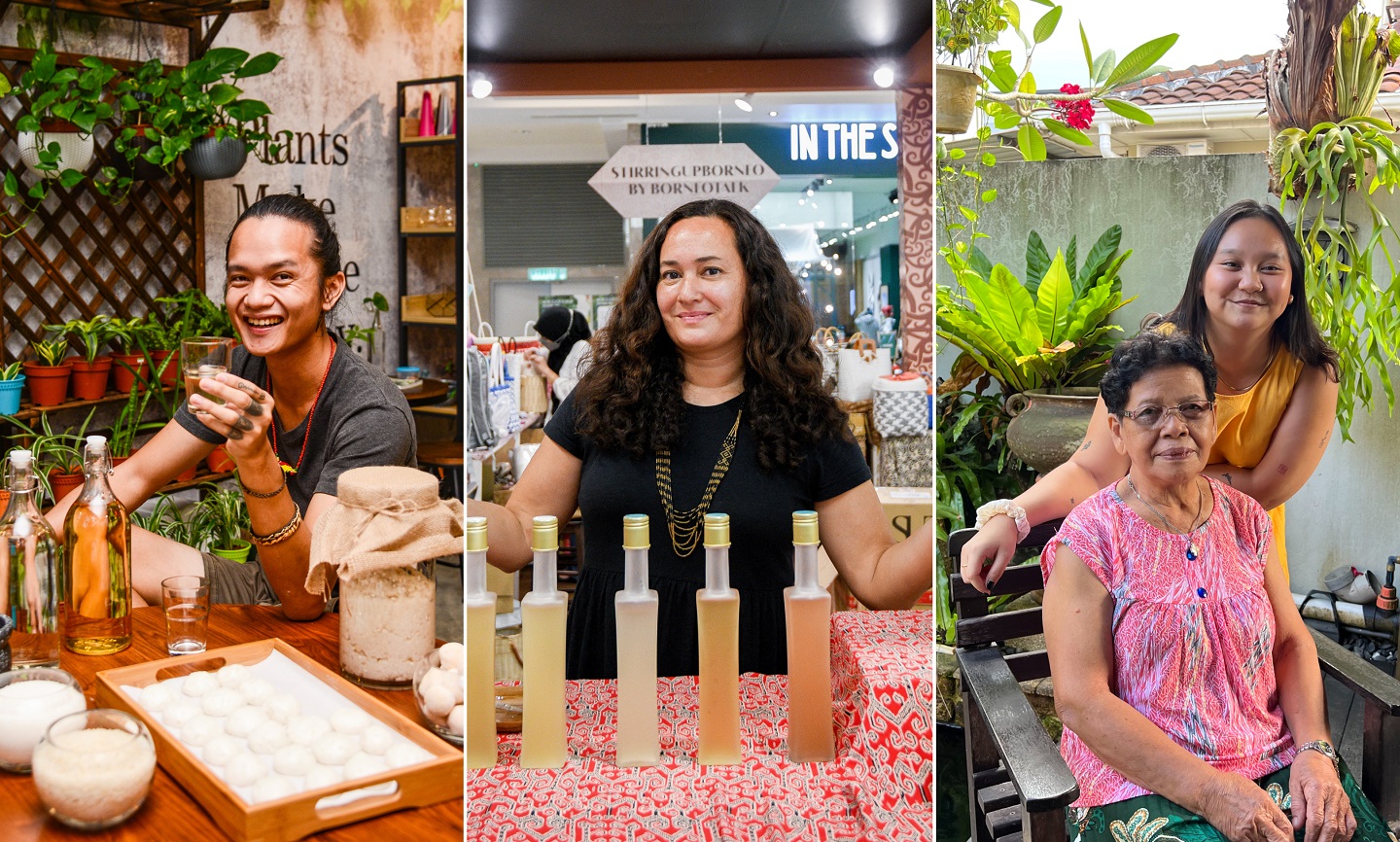
Bornean Tuak, Ooh Haa! and The Rasa Family proudly represent Miri, Bintulu and Kuching respectively (Photo: Bornean Tuak, Shahril Basri/The Edge Malaysia, The Rasa Family)
Tuak, as many people know, is an intoxicating rice wine often associated with merrymaking. It is a must-try indigenous drink whenever one visits Sarawak, but the general knowledge surrounding it usually ends there.
It is perplexing how this traditional wine, despite having existed for thousands of years, still appears to be shrouded in obscurity. This is especially so in the peninsula, although it should not come as a surprise. The social divide between East and West is the result of many factors, including an imbalance in the distribution of wealth and inadequate education, on top of the obvious geographical distance. Yet, it does not negate the fact that it takes both hands (or lands) for our country to clap.
For the Dayaks in Borneo, Hari Gawai is an auspicious celebration that marks the end of the year’s harvest. Spiritual ceremonies and rituals are held by the various ethnic groups to give thanks for the year’s bountiful yield and to ask the gods for blessings, guidance and protection for the one ensuing. Tuak is an intrinsic component of such celebrations. And while bottles and bottles are made to serve guests during house visits, the drink is also offered to ancestors and spirits. Additionally, it is handy to know that the method for making tuak not only differs from one ethnic group to the next, but also from family to family, resulting in an array of variations that possess their own distinct qualities.
To commemorate the joyous occasion, a handful of tuak brewers, with roots in various parts of Sarawak, share the lesser-known facts of the heady drink, what it means to them and the most rewarding part of preserving the art of brewing the rice wine.
For Evan Lee, founder of Bornean Tuak, it all begins with the heart and the intentions one sets before embarking on the brewing process. There is a difference in approach when it comes to brewing for a sacred ritual as opposed to for friends and family for enjoyment, he explains over a video call. “For Gawai Hantu, the tuak is served to warriors, or someone who has protected their village. Tuak represents their spirits from the ancestral world,” the 31-year-old Iban from Miri explains. “For the Gawai ceremony, we call it ai pengayu. Gayu means long life in Iban, so it is served with the intention that everyone who drinks it is blessed with longevity and good health in the coming harvest.
“In my experience, when you make it with good intentions, it will further enhance the quality of the tuak. If you just brew it for fun or with less passion, the tuak will reflect it back to you and anyone who drinks it. Is it for a festival or someone you love? Did you brew it with gratitude and respect? In that aspect, brewing has taught me to strengthen my patience.”
dsc_8309.jpg
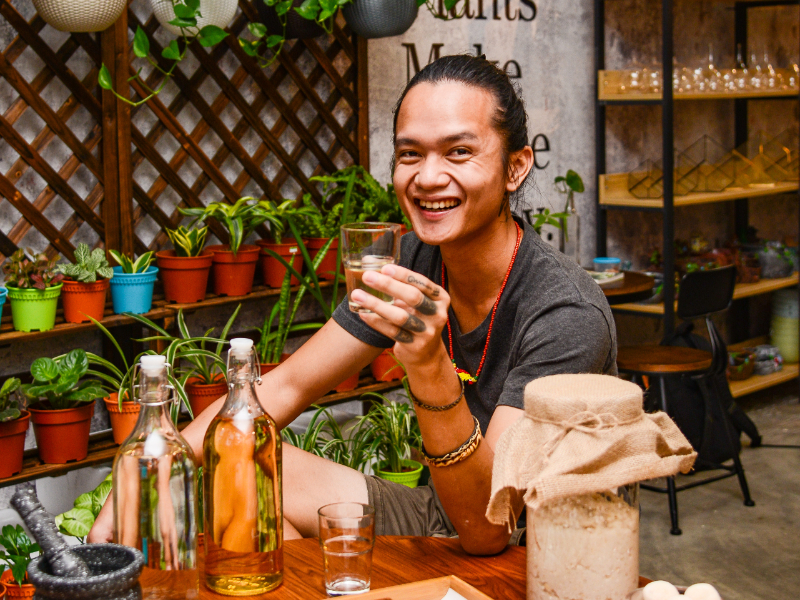
Prior to starting his business almost four years ago, Lee was in charge of grilling meat at a rumah asap in Sarawak. He is also a musician — his stage name, Anak Borneo — and often flits between Kuala Lumpur and Johor to play the sape and talk about the tuak he made on the side. He established Bornean Tuak when he moved to Selangor before the Movement Control Order was imposed. “Sometimes, we would travel up north and down south, like Ipoh, Penang and Johor to share music, tuak and the culture behind tuak brewing,” he says.
Through his travels and pursuit of the best ingredients, Lee was able to collaborate with a number of local farmers from across the country. “I want to bring out the qualities of local fruit through my tuak,” he affirms. “So, I went around looking for organic farmers who plant local rice and fruit. We approached them and talked about how they planted the and harvested their crops, from beginning to end. We have been to Long Semadoh, which is the upper river area of Lawas, north of Sarawak. In Semenanjung, I visited organic farms in Bangi and Broga. We became friends and I ordered raw materials from them like sugar cane, roselle and pineapple.”
While Bornean Tuak offers a variety of flavours, including nangka and rambutan, its pineapple tuak is perhaps the most sought-after, although it is only available once a year as it is a seasonal product. “As for the rice from Sarawak, it depends on the weather and situation. Because sometimes the grains, like Job’s Tears in Long Semadoh, get eaten by wild boars. We work fully with Mother Nature!” he laughs.
dsc_8119.jpg
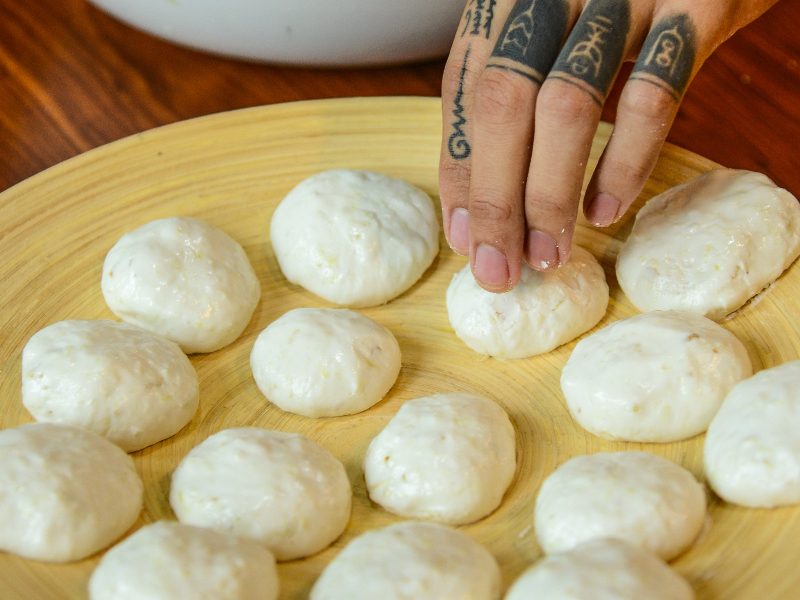
“Tuak is a very interesting and diverse drink,” says Lee, adding that different families, tribes and regions brew it their own way. “It’s the kind of thing that is fun to explore and is worth learning.” His methods were mostly taught by his aunt from Kanowit, who travelled to many longhouses to learn more about tuak brewing. Now, he passes on that knowledge to those who attend his workshops, which occasionally take place at his house in Semenyih. “Sometimes, we open our home for events like barbecues and tuak pairings, and I get back to my old job and start grilling,” he jests. “I think music mixes well with wine, and wine mixes well with barbecue. These three elements go well together. Back in the longhouses, when we grill food, we also drink and play music. It’s kind of like our kampung entertainment. So, it’s quite natural for us to do these activities.”
Lee sums up the role of tuak in Gawai for the uninitiated. “First, tuak is a drink that smoothens communication between folks. After drinking, people relax and we can connect more easily. Second, it is a drink that represents blessings. We serve it to guests in the hope that it cleanses bad omens and they get good energy from the tuak we brew. And for the most important part, it’s for you to be happy lah,” he chuckles. “Not drunk! But to be happy.”
Although the tuak brewing community is still relatively small, Lee is glad that he has found like-minded people who also yearn to strengthen and preserve the tradition. “It is a good time for us to look back to our roots, because this is what defines us as a people of this country.”
The same sentiment is shared by Lydia Lubon, a documentary filmmaker (previous stints include working with National Geographic, Discovery Channel and Al Jazeera), an environmental educator at Free Tree Society and, more recently, a tuak brewer. The Iban-American, who grew up in KL, was raised in a household that embraced both ethnicities. “I learnt Iban and English simultaneously,” says the 43-year-old. “I know I may look Mat Salleh and sound it, but I speak fluent Iban.”
Lubon grew up being exposed to her Dayak heritage and would often visit her late Iban father’s hometown in Bintulu. “My whole life, I’ve always been able to get tuak from my cousin and aunts,” she recalls. “Every time I go back to Sarawak, I’m able to just raid their cabinets, no problem. But then because of the pandemic, I wasn’t able to go back to get tuak anymore. And my nephews who brewed tuak [in KL] were recalled by their parents back to Sarawak. So I didn’t have anybody here who made it our family way.” Instead of throwing herself into baking sourdough bread or gardening, which was what everyone was doing, she borrowed her cousin’s fermentation pail and attempted to make her own rice wine. “That was my pandemic hobby,” she muses.
20220518_peo_ooh_haa_tuak_sb-12.jpg
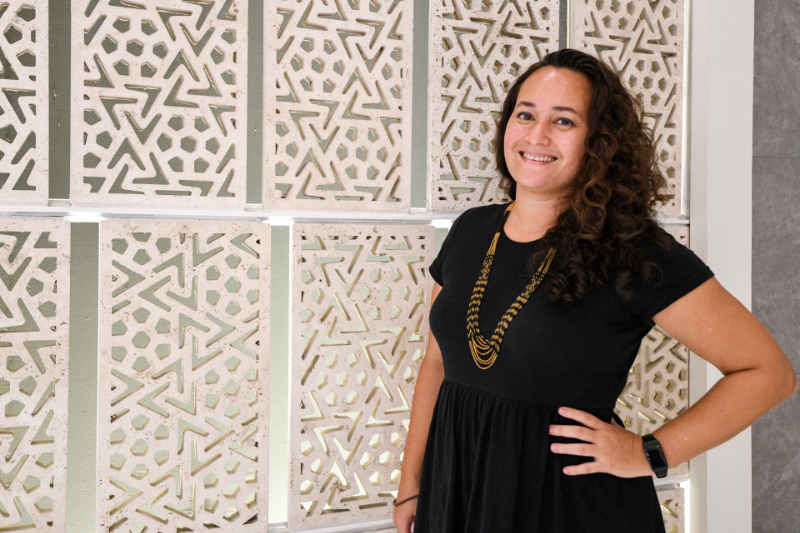
For the first few batches, Lubon was apprehensive. “I was really insecure about how my tuak tasted the first few times. I had never made it before, so I didn’t have a lot of confidence. But I shared it with one or two people and they said it tasted pretty good, so I made another batch and started to build more confidence that way.
“Then I brought it to a gathering and there were about 20 people. And they started asking, ‘Can I order this from you?’ I was so shocked that people wanted to pay me for my tuak. I got online quickly to order my own fermentation pails, and that was how it started.” The popularity of her tuak spreaded quickly through word of mouth. Her pandemic hobby evolved into a business that she named Ooh Haa!.
To manage the quality of her rice wine, Lubon kept her batches small. Nonetheless, there were a number of challenges she faced as a new brewer. “I really love fruits,” she enthuses. “I’m a tropical person, so I really wanted to go in the direction of fruit tuak. But man, was it hard.
“There are so many things that have to be in order, so the biggest hurdle for me was navigating the different flavours. The fruit tuak industry is so new that I had to learn a lot on my own. I had to call people and make friends with brewers [one of whom was Lee from Bornean Tuak] and just pick their brains.”
20220518_peo_ooh_haa_tuak_sb-11.jpg
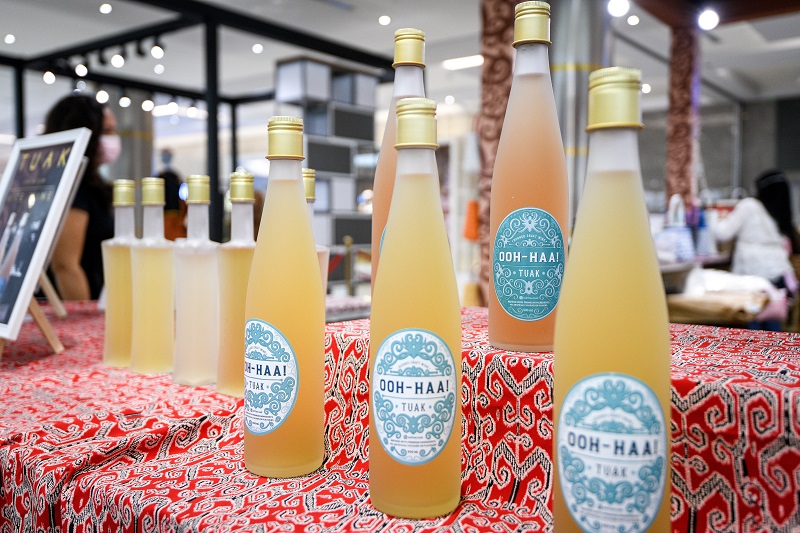
But after all the trial and error, Lubon’s selection of premium flavours would almost always sell out. “What makes me really happy is seeing the faces of my customers light up when they taste it,” she smiles. “And knowing that something I’ve made from my heart has brought enjoyment to another person is what brings me the greatest joy.” Besides that, she also does tuak tastings with her friend, Ning Ong of Chocolate Concierge. “I get to answer a lot of questions and teach people about Iban culture. So, that is very fulfilling.”
What should one pair Ooh Haa’s tuak with you might ask? She suggests breads, cheeses and salted nuts. “Because my tuak is slightly on the sweet side, it goes well with more savoury things.” Remember to ditch the wine the next time you order a charcuterie board.
As everyone’s flavour palate is different, Lubon advises people not to let one bad experience stop them from giving tuak another shot. “There are two types of tuak,” she points out. “There’s tuak laki and tuak indu. Indu means woman. Tuak indu is smoother and sweeter, whereas tuak laki is harsher and stronger. So, the man’s tuak is more like a whiskey or vodka and the woman’s tuak is more like a sauvignon blanc.”
And if you have been wondering all these while what Ooh Haa means, it is Iban for “cheers” and expressed the same way as “yam seng” in Cantonese. “I just wanted to name my brand something that’s really fun and celebratory. I love that the name is also an educational talking point for people. I’m teaching people an Iban word through my label. So, it is in alignment with one of my pillars, which is to share Iban culture outside of Sarawak,” says Lubon.
It is not often you see two extremely dissimilar generations working together, but Martiana Chia, 23, and her Bidayuh grandmother, Margaret Dobin Anak Rasa, more affectionately known as Grandma Rasa, 76, has made it work for a little over a year. Chia runs her own handmade jewellery brand, @sangon.co, but was curious about how she could share her culture with a wider audience. Since her grandmother had made and sold tuak for a long time, she decided to venture along that route.
As a child, Chia and her two siblings would watch their grandmother make tuak every week. “She usually sells only to close family and friends because she’s really secretive [about the family recipe]. Back when we were in longhouses, if there was extra, she would go door to door, asking if people wanted to buy some. She would upcycle glass bottles that used to contain kicap and vodka, and only sell her tuak for RM10.”
img_8256.jpg
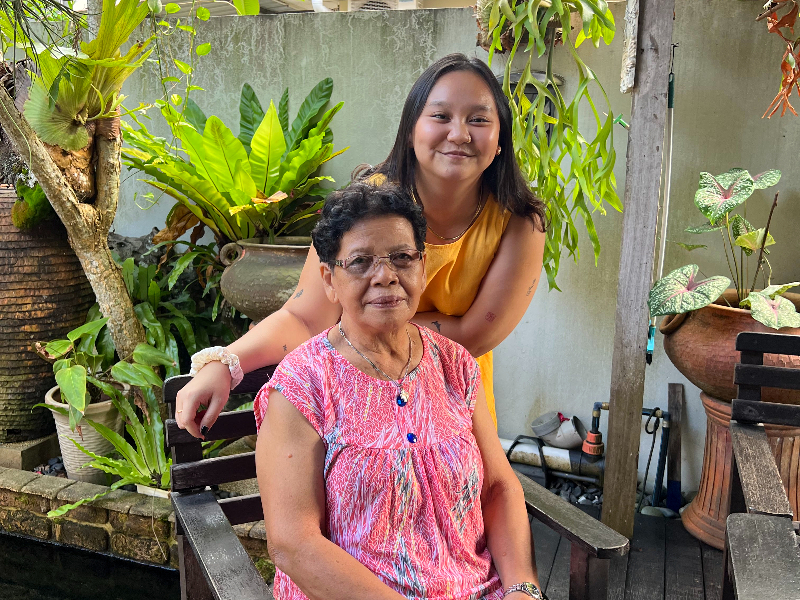
Margaret has been making her own tuak since she was 17. She learnt it from her father, who learnt it from his father and so on. After tracing the family tree as far as possible, they concluded that the recipe was about 150 years old. The soft-spoken dame, who only converses in Bidayuh and Malay, allowed her granddaughter to take charge when answering questions and translate her short replies, but she would also chime in once in a while with cheeky quips.
As the eldest of six, Margaret had to forgo her education to help raise her siblings. When her husband passed away from an illness, she started working as a government dental attendant to make ends meet. “Tuak was basically her hobby,” says Chia. “She doesn’t like baking or cooking as much. Tuak was always her thing.
“My family and I have been trying to get her to sell her tuak more publicly, but because other Dayak families do it too, she wasn’t very motivated to go ahead.” One of the most rewarding parts of starting a business together was seeing her grandmother radiate more confidence in her craft as orders increased. “When I brought her to our second pop-up in Kuching and people started lining up for testers, she started saying, ‘Yeah, I made this!’” She jokes about how since then, every few weeks, her grandmother would extend her palm and ask, “Got sale? Duit mana?”
Until recently, The Rasa Family’s tuak has always focused on a single flavour, ginger. Although the rhizome was sparingly used in the original recipe, Margaret made it the star ingredient in the tuak she sold. “Tell her a lot of people like ginger,” she says through Chia. “Ginger is really good for your health.” Margaret believes her tuak is more fragrant because the ginger is from her own garden. “I think because she is the one who plants them, she puts a lot of faith in her harvest, and that makes it more special,” says Chia.
img_9769.jpg
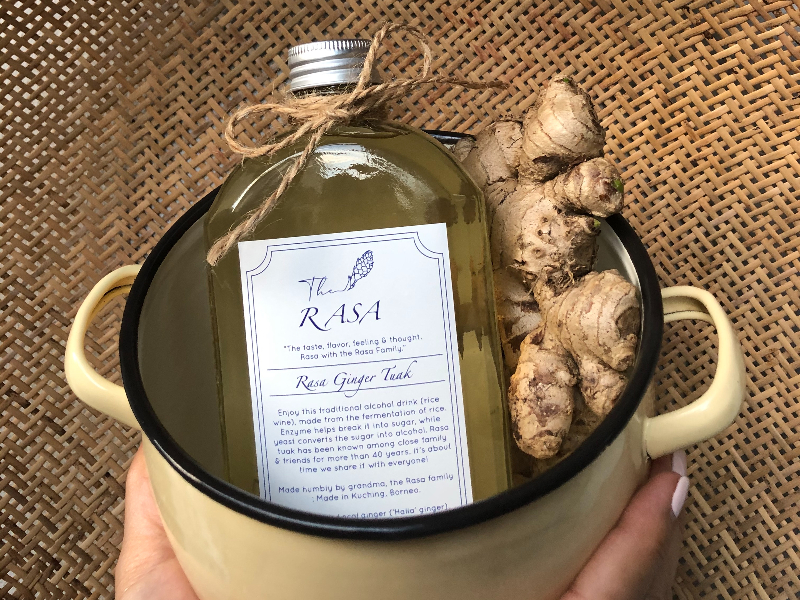
At times, when there were too many orders and not enough ingredients, the duo would source from people in the neighbourhood who had excess supply. “If it still wasn’t enough, we would get the ingredients from a local NGO in Kuching called WormingUp. They’re the ones with bigger farms and their farmers are all indigenous people.”
Initially, Chia’s role was only to handle online marketing. But right before the launch of The Rasa Family, Margaret had a minor stroke and she decided to let her granddaughter in on the secret to preserve the recipe, and Chia willingly learnt, although it was a struggle at first. She learned how the weather would affect the amount of ingredients added and grasped the value of using traditional methods, such as doing everything by hand. “It makes me see things through her eyes,” she softens. “If she can do it, then I want to do it like her, with so much grace. She doesn’t break a sweat, I promise you.”
As a Chinese-Bidayuh, Chia and her siblings have experienced their fair share of snide remarks about not being completely in touch with their Dayak roots. But after slowly improving her command of the Bidayuh language and learning the techniques of brewing tuak, she feels more accepted. Margaret expresses that she is proud of her.
Grandma Rasa concludes with a fun fact about their tuak, “Did you know if you drink ginger tuak, you cannot get drunk? That’s because it helps to expel air.”
There’s really only one way to find out.
This article first appeared on May 30, 2022 in The Edge Malaysia.


